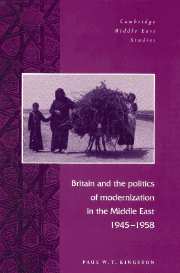Book contents
- Frontmatter
- Contents
- Acknowledgements
- Introduction
- 1 Britain, peasants, and pashas: debating approaches to modernization in the postwar Middle East
- 2 Imperial dreams and delusions: the economics of promoting Middle East modernization
- 3 The British Middle East Office and the abandonment of imperial approaches to modernization
- 4 The British Middle East Office and the politics of modernization in Iran, 1945 to 1951
- 5 The British Middle East Office and the politics of modernization in Iraq, 1945 to 1958
- 6 The British Middle East Office and the politics of modernization in Jordan, 1951 to 1958
- Conclusion: ‘hastening slowly’
- Notes
- Bibliography
- Index
4 - The British Middle East Office and the politics of modernization in Iran, 1945 to 1951
Published online by Cambridge University Press: 09 October 2009
- Frontmatter
- Contents
- Acknowledgements
- Introduction
- 1 Britain, peasants, and pashas: debating approaches to modernization in the postwar Middle East
- 2 Imperial dreams and delusions: the economics of promoting Middle East modernization
- 3 The British Middle East Office and the abandonment of imperial approaches to modernization
- 4 The British Middle East Office and the politics of modernization in Iran, 1945 to 1951
- 5 The British Middle East Office and the politics of modernization in Iraq, 1945 to 1958
- 6 The British Middle East Office and the politics of modernization in Jordan, 1951 to 1958
- Conclusion: ‘hastening slowly’
- Notes
- Bibliography
- Index
Summary
Modernization and development have been an integral part of Iran's modern history. In the nineteenth century, Iran had been a weak and fragmented state over which a monarch reigned but in many ways did not rule. Saddled with divisions along geographic, ethnic, religious, and linguistic lines, Iran's rulers were never able to consolidate the power of the central state, let alone pursue a policy of integration and development. Neither were there strong westernizing influences from Europe to act as an imposed catalyst for change, certainly in comparison to the Ottoman Empire which found itself caught up in the whole Eastern Question. The result was the formation of a state in nineteenth-century Iran which has been described as ‘pre-modern’.
A change of dynasties after the First World War which brought Reza Shah Pahlavi to power ushered in a period of intense socio-economic and state-led reform that continued until the overthrow of the Pahlavi dynasty in the Iranian Revolution of 1979. The only notable exception to this general trend were the years between 1941 to 1953 which most concern us here. Mirroring the étatist policies of Ataturk in neighbouring Turkey, Reza Shah initiated a state-led modernization programme aimed at integrating the country through the establishment of a modernized military, an enlarged bureaucracy, an improved system of infrastructure, and an industrial base. By the outbreak of the Second World War, it appeared as though Iran had travelled a considerable distance down this road to modernity.
As was the case throughout the region, the Second World War revealed the shaky foundations on which Reza Shah's ‘modern’ Iran had been built.
- Type
- Chapter
- Information
- Publisher: Cambridge University PressPrint publication year: 1996



